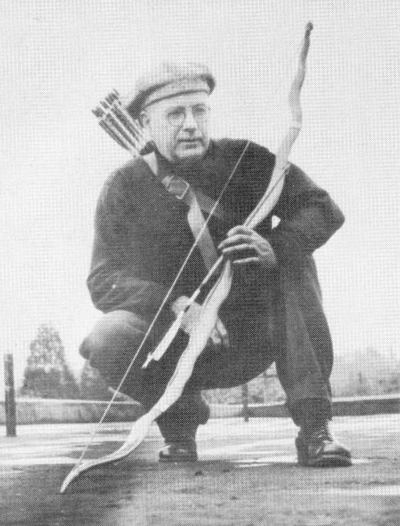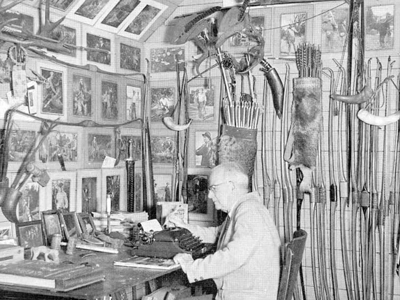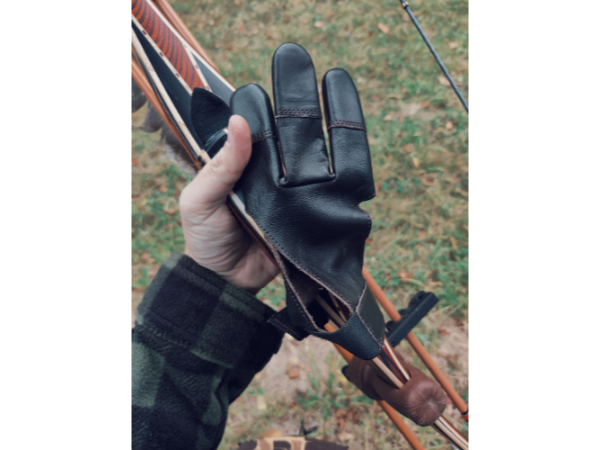This article was written in 1990 by the late Dave Doran of Bend, Oregon.
I first met Chet in 1975. I had heard about him from Larry D. Jones. We were mostly interested in making and hunting with yew bows, so Larry said I should meet him since Chet had taken quite a few animals with a yew bow. Two of those animals were blacktail deer, one taken in 1917 and ranking #5 in the Pope & Young Club’s record book. The other ranked # 10. Even now those deer rank #10 and #22, respectively.
But Chester Stevenson was much more than an expert bowhunter. His chosen profession was photography. Even now I occasionally run into an old timer that new him for his picture taking ability. Many bowhunters may remember the name Tom O’Clayton from the National Bowhunter magazine, where Chet had a column entitled “From The Den Of The Old Bowhunter”. He was also an accomplished bowyer, having ever 100 in his den at one time, mostly made by him. His snake bows were made of curly yew and Osage. He had over 20 in different weights and they all shot well—some many thousands of times. Chet once told me about a pair of billets given to him by Fred Bear. I have since found an article written by him in the ‘50s about this gift. I’ll repeat some of it. It starts off about a package he received from Detroit in 1938.
 “It was heavy, and when I opened it I found this pair of rare billets . . . I sized them up for a few days and then went to work. It took more than just days to make, but the result was a prize. At the top end is a horn nock, the exact replica of a rattlesnake’s head and the bottom is a snake’s tail with nine rattles.” Later correspondence from Fred Bear related that “I decided that a friend of mine by the name of Chester Stevenson—with a knack for making a beautiful bow—could probably produce the kind of weapon I had in mind. I went to the chap and he did produce a most unique and beautiful bow which fully repaid me for the care I had given to the billets.”
“It was heavy, and when I opened it I found this pair of rare billets . . . I sized them up for a few days and then went to work. It took more than just days to make, but the result was a prize. At the top end is a horn nock, the exact replica of a rattlesnake’s head and the bottom is a snake’s tail with nine rattles.” Later correspondence from Fred Bear related that “I decided that a friend of mine by the name of Chester Stevenson—with a knack for making a beautiful bow—could probably produce the kind of weapon I had in mind. I went to the chap and he did produce a most unique and beautiful bow which fully repaid me for the care I had given to the billets.”
Chet died at the age of 94. Once, I was visiting, he related some stories that took place in the early 1900s. He was 90 at the time and was remembering experiences that had happened over two of my lifetimes ago.
My favorite article by Chet was a lament of the South Fork (South Fork of the McKenzie River in Oregon), when it was dammed and many of his camps and hunting places were buried under 400 feet of water. These were camps where their first camp was in 1907, where many times the meat was canned on the spot and trips were several weeks, even though the area is now less than an hour’s drive from Eugene. “This is an example of what is happening to thousands of this nation’s hunting areas,” he said. Even then during the time of plenty, Chet realized what was happening with our natural resources.
When we think of the people who were responsible for the use of the bow and arrow becoming popular for hunting, it’s usually the Thompsons or Hill or Pope & Young. And no doubt they were real leaders. But the people from local communities play a no less important part. Chet was one of those people; a real shot from the past.







Leave A Comment